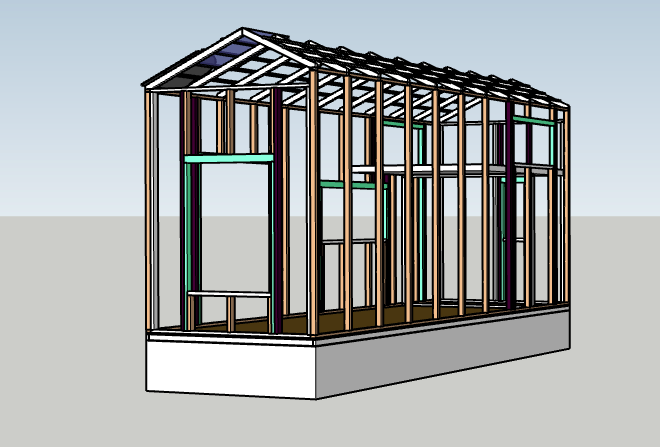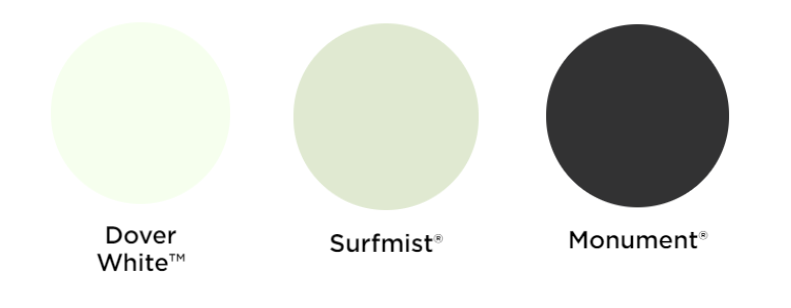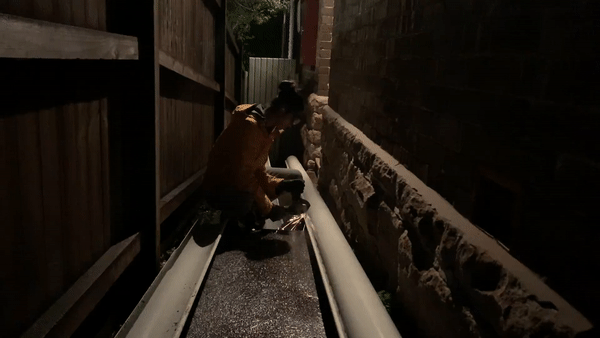Operation Find a Roof
Operation Find a Roof
As Lys sits down to write this she can officially say that we have sourced all of our roof components! It is a mixture of second hand material and some first-hand non-negotiable(s) but it’s great to finally have all the bits and bobs.
Table Of Contents
The Design
We chose to have a slightly off centred gable roof for our tiny house. Technically this is known as a saltbox pitch style but we have not found that term used commonly in Australia. We wanted to keep the traditional house style compared to some of the more modern tiny house options. The style is also quite useful for maximising solar panels on a small space and this will be helpful if we decide to go off-grid. It is also simple to construct as there are minimal valleys or curves which makes it great for novice builders also known as cough us.

Our roof design
We are going to have a roof pitch of 20 degrees (which is standard for most houses and easier to find second hand materials for) even though we could have as little as a 5 degree roof pitch for a gable roof. Most tiny houses choose a shed style or flat roof which is technically more space economical as one can get more internal head height but we really liked the more traditional aesthetic. There is just something so comfortable and cosy about a gable roof.

Gable, Saltbox, Flat and Shed roof styles are all common tiny house options
The Material
Metal was our go to choice for a roof - it’s light, relatively affordable and easy to come by on the second hand market. Often larger jobs will order 10% extra as leeway and sell the remainder. We actually found our Colorbond from a lovely family fixing a shed, a elderly couple redoing a carport and a renovation on the Central Coast.
On our way up from the Central Coast we had this brilliant idea to cut the Colorbond panelling with tin snips to fit the sheets into the van. It turns out that it is incredibly difficult to cut corrugated iron with tin snips (think of these like scissors for metal) over long distances and most people just use a circular saw or angle grinder. Luckily we had a rope that Erny was given from another pick up and we bundled 6m pieces of Colorbond into the back of the van and tied the boot closed for a 1.5hr drive home. Note to self - always bring a circular saw!
But what about the colour?
Lys absolutely adores a dark coloured and black roof. It is the current tiny house trend at the moment and looks very sleek, blending into the the environment if it is particularly verdant. The building industry also loves a good dark roof as well1.
That being said - the colour is not the ideal colour in sunny Australia, or anywhere warm in this changing climate2. Long story short - dark coloured surfaces absorb more heat energy than lighter colours. In a roofing context this heats the roof cavity of your home and - unless you have great insulation - heats the interior of your home. On a broader scale, with urban sprawl suburbs can fall victim to the Urban Heat Island3 effect - where urban centers are significantly warmer than rural areas due to having less trees and more dark surfaces.
At one point in time Australian states were looking to ban dark coloured roofs on new developments.
Having said this - a tiny house roof is very small so in the grand scheme of things it probably won’t matter, but as Australia’s cities experience more urban sprawl it is more important than ever to make small steps to heat-proof abodes - and this means Lys must sacrifice her dark coloured roof.
So we are going with Surf Mist as our roof colour! Solar Absorptance (SA) is the proportion of the total incident solar radiation that is absorbed by the roofing material (the remainder is reflected) and a roof with a lower solar absorptance will absorb less heat than a roof with a higher solar absorptance. Theoretically, this should keep the roof space and building cooler on a hot day.
Surfmist has a SA of 0.32 - compared to Monument (an incredibly popular tiny house roof colour) which has a SA of 0.71. Obviously if we had our time again we’d love to use Whitehaven or Dover White (SA of 0.23) but it seems like it is not available for retail consumers, rather it is an architectural offering only.

Classic Colorbond Colours
Gutters
We found the gutters in the Haberfield of all places. A heritage listed house had accidentally ordered the incorrect gutter type in the colour that we were looking for (Surfmist) and we pounced. We ended up getting them for free as well 😄 We actually ended up using the same rope to secure our gutters in the van - we suppose the real take away here is always bring a rope when picking up second hand construction items.

Taking off gutters
Sundry Items
It was most difficult trying to find flashing, ridge caps and rivets second hand. We ended up purchasing on the first-hand market (and rust is a thing so we thought this would be the best approach). This posed another problem as most suppliers are not interested in servicing such a small job or they are a full service fit out (i.e. they provide the product and the installation service). Other vendors wouldn’t match the existing gutters that we had or were not based in our state - shipping costs are a killer! Additionally, with rising construction costs website prices were inflated from 5% - 20% on the personalized quote.
Luckily we found Jack from Roofit Online which had an online store (because as we know Millennials avoid talking on the phone like the plague) and 24/7 customer service. They specialise in Colorbond and locally manufacture. What they can’t make they source though their team based in NSW as well.They also take all types of jobs no matter how small which is great when building a tiny house. Jack was super patient and chucked a 5% discount - thanks Jack! We only have good things to say.
So here we are - one nerdy rant later about roof colours and we are a little bit closer to putting ours up!
Catch ya later, Lys & Erny
-
If you feel extra nerdy Lys found this paper on roof performance around the world a great read ↩︎
-
Urban Heat Island Effect is a term used to describe the outer suburbs of major cities with minimal tree cover. Interesting articles from the Climate Council can be read here and from Adapt NSW here ↩︎

Thank You!
Your comment has been submitted. It will appear on this page shortly! OKYikes, Sorry!
Error occured. Couldn't submit your comment. Please try again. Thank You! OK